Impact of Motivation on Employee Productivity: White Oaks Saloon
VerifiedAdded on 2022/11/14
|40
|9559
|5
Report
AI Summary
This report investigates the factors contributing to the lack of employee motivation and its subsequent impact on productivity at White Oaks Saloon Bar and Dining. The study utilizes a pragmatic research philosophy, descriptive research design, and a deductive research approach, collecting primary data through surveys from nine employees. The findings highlight key issues such as high work stress, ineffective management, negative managerial attitudes, and a lack of employee engagement and development programs as significant contributors to employee demotivation. The research recommends implementing effective management practices, training programs, fair wages, and employee engagement activities to improve employee motivation and address the negative effects of low motivation. The report also includes an executive summary, literature review, research methodology, detailed findings, discussion, recommendations, and conclusions, along with limitations and references, providing a comprehensive analysis of the issue and practical solutions for White Oaks Saloon.
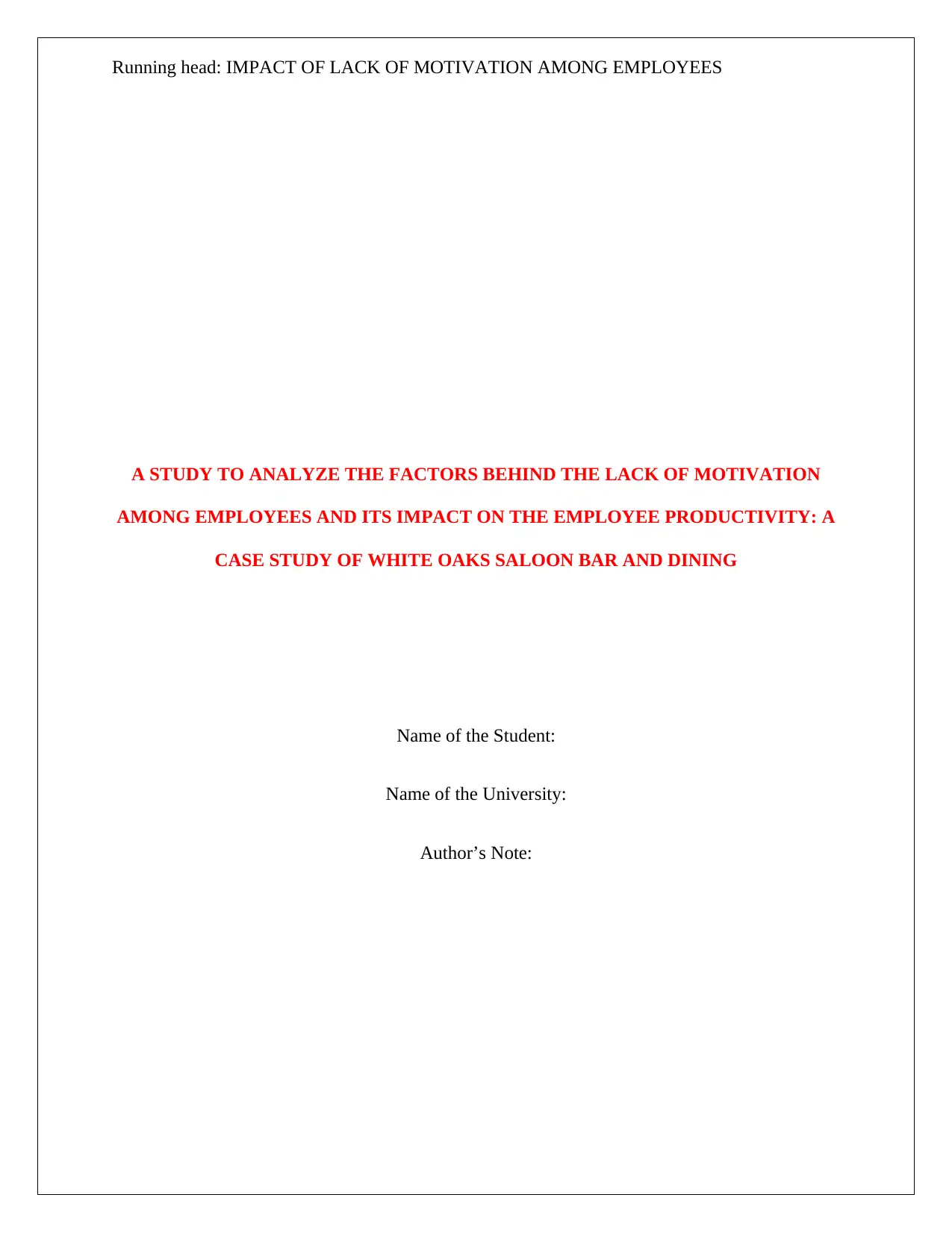
Running head: IMPACT OF LACK OF MOTIVATION AMONG EMPLOYEES
A STUDY TO ANALYZE THE FACTORS BEHIND THE LACK OF MOTIVATION
AMONG EMPLOYEES AND ITS IMPACT ON THE EMPLOYEE PRODUCTIVITY: A
CASE STUDY OF WHITE OAKS SALOON BAR AND DINING
Name of the Student:
Name of the University:
Author’s Note:
A STUDY TO ANALYZE THE FACTORS BEHIND THE LACK OF MOTIVATION
AMONG EMPLOYEES AND ITS IMPACT ON THE EMPLOYEE PRODUCTIVITY: A
CASE STUDY OF WHITE OAKS SALOON BAR AND DINING
Name of the Student:
Name of the University:
Author’s Note:
Paraphrase This Document
Need a fresh take? Get an instant paraphrase of this document with our AI Paraphraser
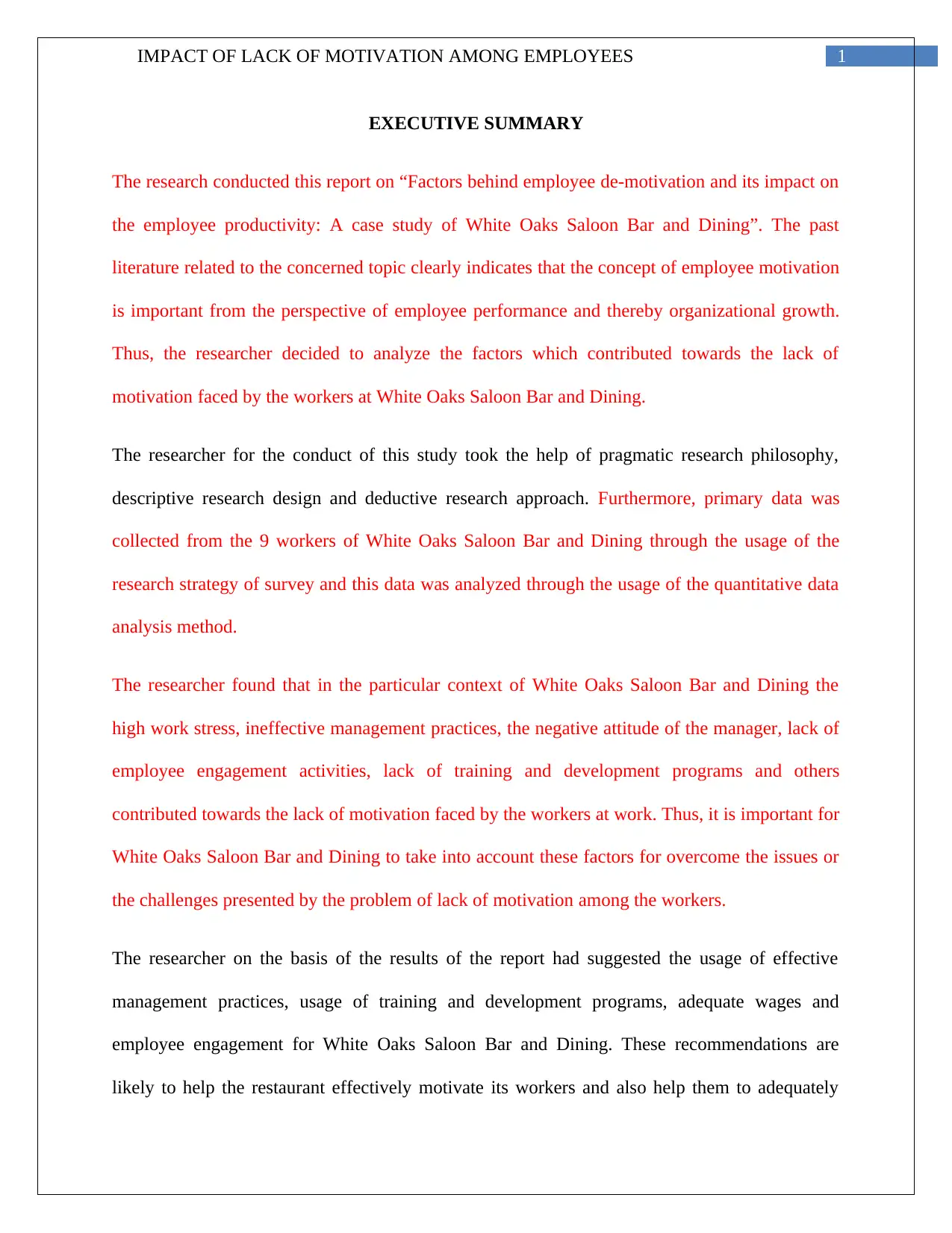
1IMPACT OF LACK OF MOTIVATION AMONG EMPLOYEES
EXECUTIVE SUMMARY
The research conducted this report on “Factors behind employee de-motivation and its impact on
the employee productivity: A case study of White Oaks Saloon Bar and Dining”. The past
literature related to the concerned topic clearly indicates that the concept of employee motivation
is important from the perspective of employee performance and thereby organizational growth.
Thus, the researcher decided to analyze the factors which contributed towards the lack of
motivation faced by the workers at White Oaks Saloon Bar and Dining.
The researcher for the conduct of this study took the help of pragmatic research philosophy,
descriptive research design and deductive research approach. Furthermore, primary data was
collected from the 9 workers of White Oaks Saloon Bar and Dining through the usage of the
research strategy of survey and this data was analyzed through the usage of the quantitative data
analysis method.
The researcher found that in the particular context of White Oaks Saloon Bar and Dining the
high work stress, ineffective management practices, the negative attitude of the manager, lack of
employee engagement activities, lack of training and development programs and others
contributed towards the lack of motivation faced by the workers at work. Thus, it is important for
White Oaks Saloon Bar and Dining to take into account these factors for overcome the issues or
the challenges presented by the problem of lack of motivation among the workers.
The researcher on the basis of the results of the report had suggested the usage of effective
management practices, usage of training and development programs, adequate wages and
employee engagement for White Oaks Saloon Bar and Dining. These recommendations are
likely to help the restaurant effectively motivate its workers and also help them to adequately
EXECUTIVE SUMMARY
The research conducted this report on “Factors behind employee de-motivation and its impact on
the employee productivity: A case study of White Oaks Saloon Bar and Dining”. The past
literature related to the concerned topic clearly indicates that the concept of employee motivation
is important from the perspective of employee performance and thereby organizational growth.
Thus, the researcher decided to analyze the factors which contributed towards the lack of
motivation faced by the workers at White Oaks Saloon Bar and Dining.
The researcher for the conduct of this study took the help of pragmatic research philosophy,
descriptive research design and deductive research approach. Furthermore, primary data was
collected from the 9 workers of White Oaks Saloon Bar and Dining through the usage of the
research strategy of survey and this data was analyzed through the usage of the quantitative data
analysis method.
The researcher found that in the particular context of White Oaks Saloon Bar and Dining the
high work stress, ineffective management practices, the negative attitude of the manager, lack of
employee engagement activities, lack of training and development programs and others
contributed towards the lack of motivation faced by the workers at work. Thus, it is important for
White Oaks Saloon Bar and Dining to take into account these factors for overcome the issues or
the challenges presented by the problem of lack of motivation among the workers.
The researcher on the basis of the results of the report had suggested the usage of effective
management practices, usage of training and development programs, adequate wages and
employee engagement for White Oaks Saloon Bar and Dining. These recommendations are
likely to help the restaurant effectively motivate its workers and also help them to adequately

2IMPACT OF LACK OF MOTIVATION AMONG EMPLOYEES
handle their work load. This in turn is likely to help White Oaks Saloon Bar and Dining to
overcome the negative effects of the issues presented by the lack of motivation among its
workers.
handle their work load. This in turn is likely to help White Oaks Saloon Bar and Dining to
overcome the negative effects of the issues presented by the lack of motivation among its
workers.
⊘ This is a preview!⊘
Do you want full access?
Subscribe today to unlock all pages.

Trusted by 1+ million students worldwide
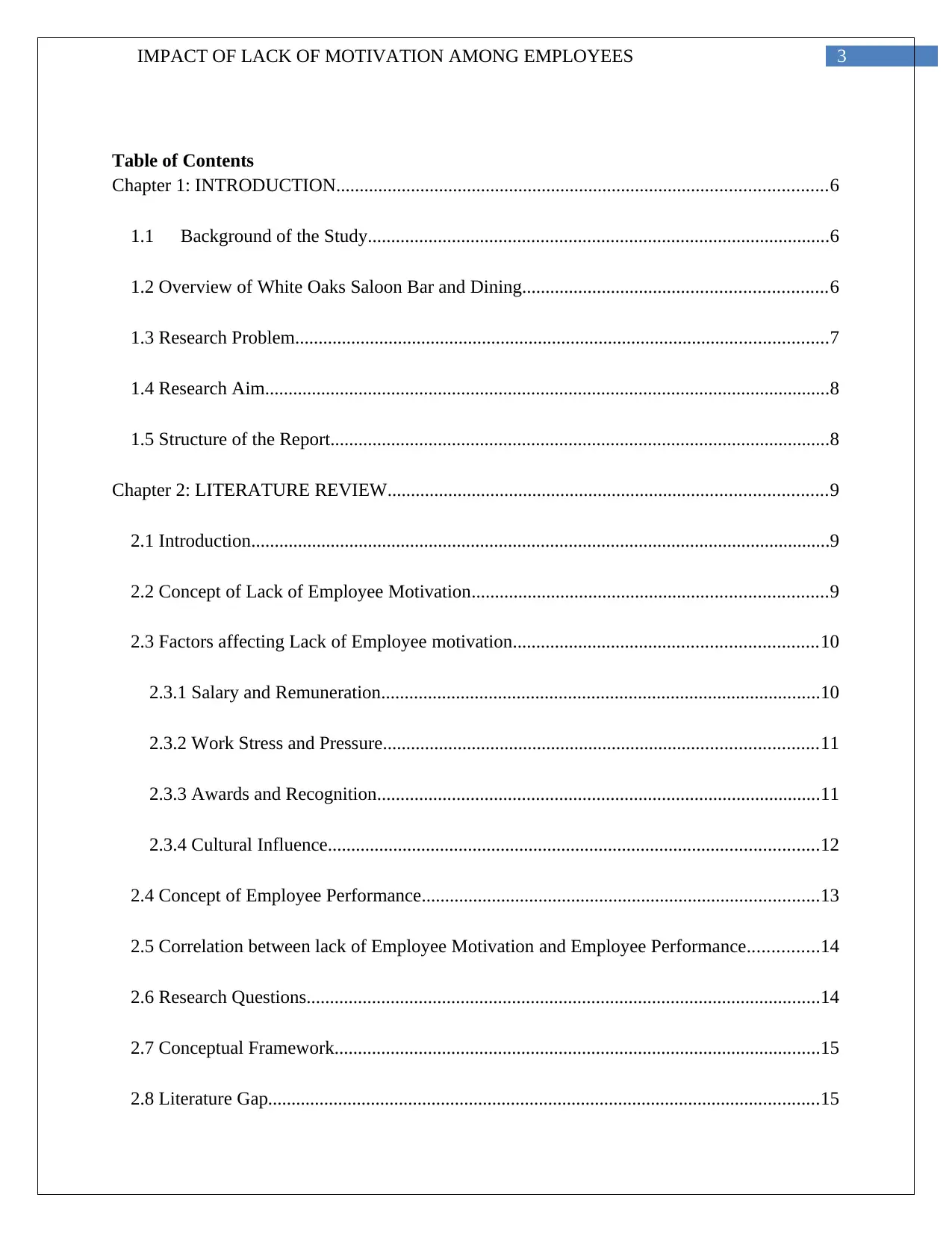
3IMPACT OF LACK OF MOTIVATION AMONG EMPLOYEES
Table of Contents
Chapter 1: INTRODUCTION.........................................................................................................6
1.1 Background of the Study...................................................................................................6
1.2 Overview of White Oaks Saloon Bar and Dining.................................................................6
1.3 Research Problem..................................................................................................................7
1.4 Research Aim.........................................................................................................................8
1.5 Structure of the Report...........................................................................................................8
Chapter 2: LITERATURE REVIEW..............................................................................................9
2.1 Introduction............................................................................................................................9
2.2 Concept of Lack of Employee Motivation............................................................................9
2.3 Factors affecting Lack of Employee motivation.................................................................10
2.3.1 Salary and Remuneration..............................................................................................10
2.3.2 Work Stress and Pressure.............................................................................................11
2.3.3 Awards and Recognition...............................................................................................11
2.3.4 Cultural Influence.........................................................................................................12
2.4 Concept of Employee Performance.....................................................................................13
2.5 Correlation between lack of Employee Motivation and Employee Performance...............14
2.6 Research Questions..............................................................................................................14
2.7 Conceptual Framework........................................................................................................15
2.8 Literature Gap......................................................................................................................15
Table of Contents
Chapter 1: INTRODUCTION.........................................................................................................6
1.1 Background of the Study...................................................................................................6
1.2 Overview of White Oaks Saloon Bar and Dining.................................................................6
1.3 Research Problem..................................................................................................................7
1.4 Research Aim.........................................................................................................................8
1.5 Structure of the Report...........................................................................................................8
Chapter 2: LITERATURE REVIEW..............................................................................................9
2.1 Introduction............................................................................................................................9
2.2 Concept of Lack of Employee Motivation............................................................................9
2.3 Factors affecting Lack of Employee motivation.................................................................10
2.3.1 Salary and Remuneration..............................................................................................10
2.3.2 Work Stress and Pressure.............................................................................................11
2.3.3 Awards and Recognition...............................................................................................11
2.3.4 Cultural Influence.........................................................................................................12
2.4 Concept of Employee Performance.....................................................................................13
2.5 Correlation between lack of Employee Motivation and Employee Performance...............14
2.6 Research Questions..............................................................................................................14
2.7 Conceptual Framework........................................................................................................15
2.8 Literature Gap......................................................................................................................15
Paraphrase This Document
Need a fresh take? Get an instant paraphrase of this document with our AI Paraphraser
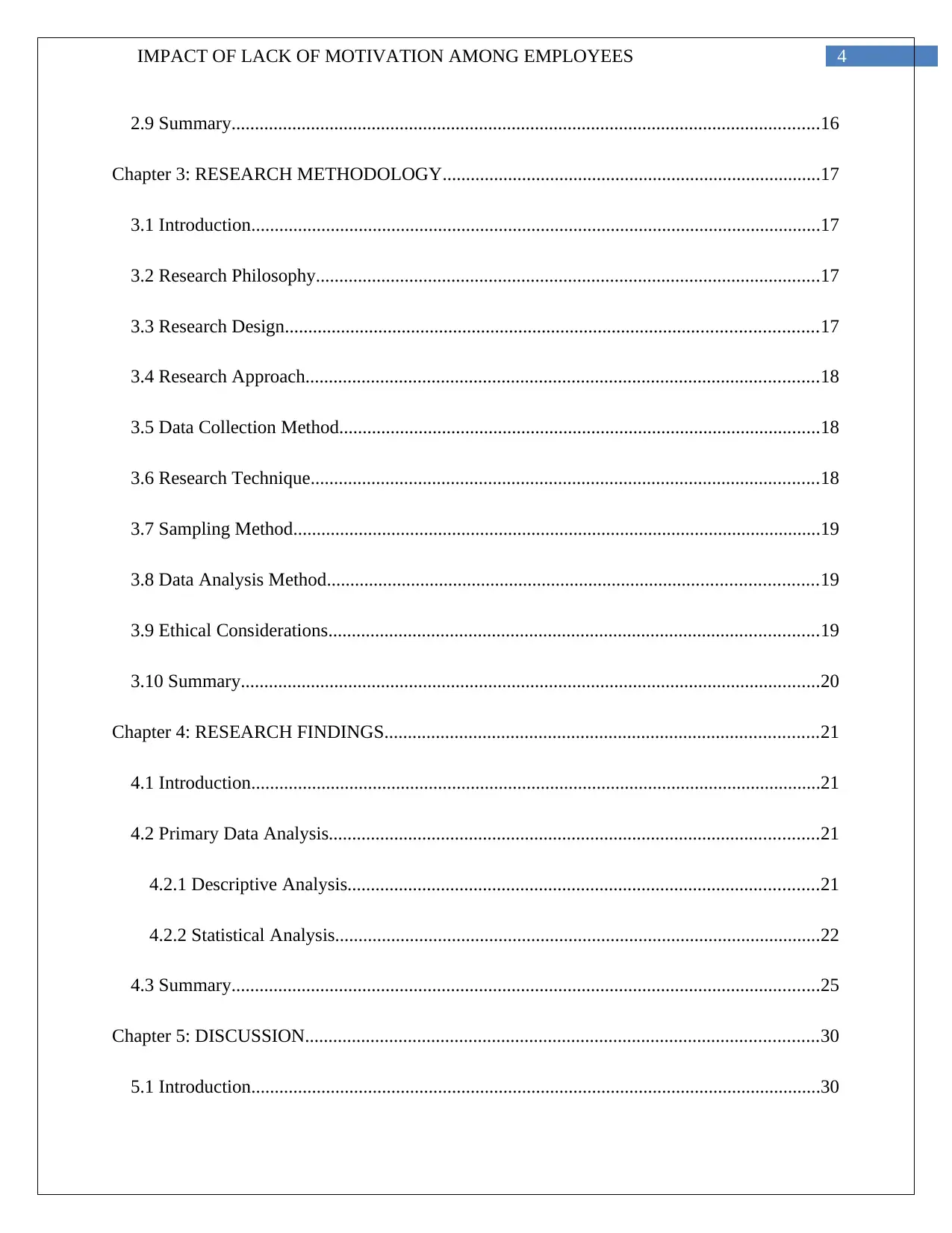
4IMPACT OF LACK OF MOTIVATION AMONG EMPLOYEES
2.9 Summary..............................................................................................................................16
Chapter 3: RESEARCH METHODOLOGY.................................................................................17
3.1 Introduction..........................................................................................................................17
3.2 Research Philosophy............................................................................................................17
3.3 Research Design..................................................................................................................17
3.4 Research Approach..............................................................................................................18
3.5 Data Collection Method.......................................................................................................18
3.6 Research Technique.............................................................................................................18
3.7 Sampling Method.................................................................................................................19
3.8 Data Analysis Method.........................................................................................................19
3.9 Ethical Considerations.........................................................................................................19
3.10 Summary............................................................................................................................20
Chapter 4: RESEARCH FINDINGS.............................................................................................21
4.1 Introduction..........................................................................................................................21
4.2 Primary Data Analysis.........................................................................................................21
4.2.1 Descriptive Analysis.....................................................................................................21
4.2.2 Statistical Analysis........................................................................................................22
4.3 Summary..............................................................................................................................25
Chapter 5: DISCUSSION..............................................................................................................30
5.1 Introduction..........................................................................................................................30
2.9 Summary..............................................................................................................................16
Chapter 3: RESEARCH METHODOLOGY.................................................................................17
3.1 Introduction..........................................................................................................................17
3.2 Research Philosophy............................................................................................................17
3.3 Research Design..................................................................................................................17
3.4 Research Approach..............................................................................................................18
3.5 Data Collection Method.......................................................................................................18
3.6 Research Technique.............................................................................................................18
3.7 Sampling Method.................................................................................................................19
3.8 Data Analysis Method.........................................................................................................19
3.9 Ethical Considerations.........................................................................................................19
3.10 Summary............................................................................................................................20
Chapter 4: RESEARCH FINDINGS.............................................................................................21
4.1 Introduction..........................................................................................................................21
4.2 Primary Data Analysis.........................................................................................................21
4.2.1 Descriptive Analysis.....................................................................................................21
4.2.2 Statistical Analysis........................................................................................................22
4.3 Summary..............................................................................................................................25
Chapter 5: DISCUSSION..............................................................................................................30
5.1 Introduction..........................................................................................................................30
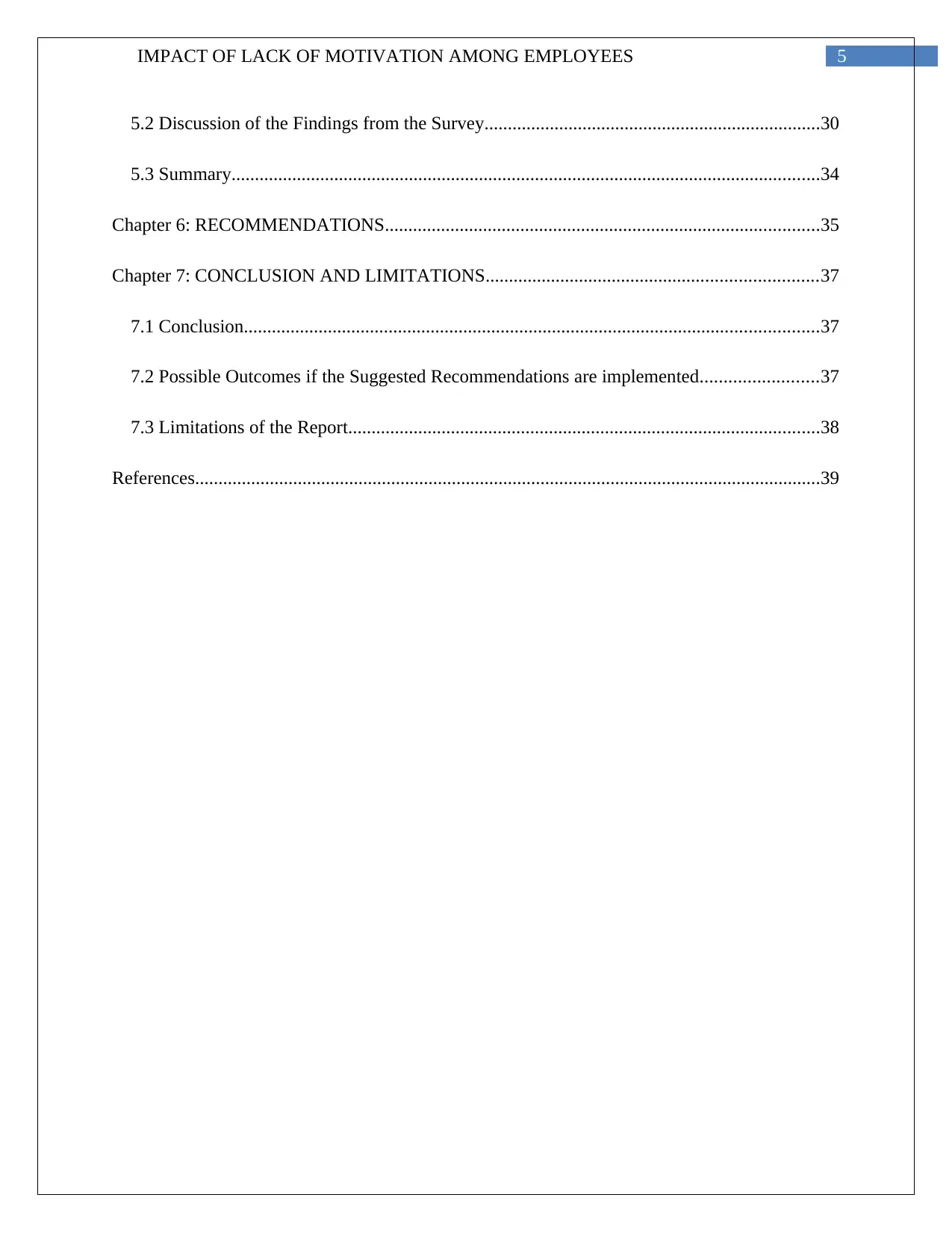
5IMPACT OF LACK OF MOTIVATION AMONG EMPLOYEES
5.2 Discussion of the Findings from the Survey........................................................................30
5.3 Summary..............................................................................................................................34
Chapter 6: RECOMMENDATIONS.............................................................................................35
Chapter 7: CONCLUSION AND LIMITATIONS.......................................................................37
7.1 Conclusion...........................................................................................................................37
7.2 Possible Outcomes if the Suggested Recommendations are implemented.........................37
7.3 Limitations of the Report.....................................................................................................38
References......................................................................................................................................39
5.2 Discussion of the Findings from the Survey........................................................................30
5.3 Summary..............................................................................................................................34
Chapter 6: RECOMMENDATIONS.............................................................................................35
Chapter 7: CONCLUSION AND LIMITATIONS.......................................................................37
7.1 Conclusion...........................................................................................................................37
7.2 Possible Outcomes if the Suggested Recommendations are implemented.........................37
7.3 Limitations of the Report.....................................................................................................38
References......................................................................................................................................39
⊘ This is a preview!⊘
Do you want full access?
Subscribe today to unlock all pages.

Trusted by 1+ million students worldwide

6IMPACT OF LACK OF MOTIVATION AMONG EMPLOYEES
Chapter 1: INTRODUCTION
1.1 Background of the Study
As stated by Wang et al. (2017), workplace productivity of the workers greatly depends on
the level of their motivation which in turn is being determined by a plethora of other factors.
Han, Bonn and Cho (2016) are of the viewpoint that the job design, reward and recognition,
leadership or the management approach followed by the business corporations, work-life
balance, employee engagement and others are some of the major factors which influence the
aspect of employee motivation. Adding to this, Shaikh, Shah and Shaikh (2018) have noted that
the employees who are highly motivated feel less work stress and also likely to have a higher
level of wellbeing as well as job satisfaction. These in turn positively affects the employee
productivity and thereby helps the business corporations to attain the desired level of growth
(Akgunduz and Eryilmaz 2018). However, at the same time it had been seen that lack of
motivation among the employees not only adversely affects employee productivity or for that
matter the quality or the quantity of the work performed by them but also negatively affects the
day-to-day operations of the business corporations (Yeh and Huan 2017). It is in the light of
these aspects that the researcher had decided to undertake this particular report.
1.2 Overview of White Oaks Saloon Bar and Dining
White Oaks Saloon Bar and Dining, located at 115-117 Greville St. Prahran VIC,
specializes in offering different varieties of cocktails and South American food to the customers.
For instance, the menu of the concerned restaurant consists of a wide array of craft beers, wine,
spirits and cocktails and these in turn have made it the central hub for the South American food
or for that matter the beverage lovers in the recent times. In addition to these, it had been seen
Chapter 1: INTRODUCTION
1.1 Background of the Study
As stated by Wang et al. (2017), workplace productivity of the workers greatly depends on
the level of their motivation which in turn is being determined by a plethora of other factors.
Han, Bonn and Cho (2016) are of the viewpoint that the job design, reward and recognition,
leadership or the management approach followed by the business corporations, work-life
balance, employee engagement and others are some of the major factors which influence the
aspect of employee motivation. Adding to this, Shaikh, Shah and Shaikh (2018) have noted that
the employees who are highly motivated feel less work stress and also likely to have a higher
level of wellbeing as well as job satisfaction. These in turn positively affects the employee
productivity and thereby helps the business corporations to attain the desired level of growth
(Akgunduz and Eryilmaz 2018). However, at the same time it had been seen that lack of
motivation among the employees not only adversely affects employee productivity or for that
matter the quality or the quantity of the work performed by them but also negatively affects the
day-to-day operations of the business corporations (Yeh and Huan 2017). It is in the light of
these aspects that the researcher had decided to undertake this particular report.
1.2 Overview of White Oaks Saloon Bar and Dining
White Oaks Saloon Bar and Dining, located at 115-117 Greville St. Prahran VIC,
specializes in offering different varieties of cocktails and South American food to the customers.
For instance, the menu of the concerned restaurant consists of a wide array of craft beers, wine,
spirits and cocktails and these in turn have made it the central hub for the South American food
or for that matter the beverage lovers in the recent times. In addition to these, it had been seen
Paraphrase This Document
Need a fresh take? Get an instant paraphrase of this document with our AI Paraphraser

7IMPACT OF LACK OF MOTIVATION AMONG EMPLOYEES
that the concerned restaurant is operational for the past five years and in order to effectively
manage the backstage and the front-stage activities it had around 9 employees. Furthermore, on
weekdays the restaurant opens for dinner whereas in the weekends it also offers lunch services to
the customers. More importantly, the restaurant under discussion here offers the opportunity to
the customers to organize different kinds of events like birthday parties, bar tender competition,
anniversaries and others which in turn had substantially enhanced the customer engagement and
thereby helped in the growth of the restaurant. However, the most important problem that the
restaurant is presently facing can be attributed to the aspect of the lack of motivation among its
workers because of which in the past six months 4 to 5 employees have left the restaurant.
1.3 Research Problem
In the context of White Oaks Saloon Bar and Dining, it had been seen that the employee-
employer relationship is not congenial. Furthermore, it is seen that there is a low level of
motivation among the employees working both in the backend and the frontend of the restaurant.
For instance, lack of insurance policies, high employee maintenance cost, lack of adequate
working space and others have directly contributed towards the problem of lack of motivation
among the employees that White Oaks Saloon Bar and Dining is presently facing. More
importantly, the low motivation of the employees has started to take a toll on their job
satisfaction and this in turn had substantially enhanced the employee attrition rate of the
restaurant. These in turn is presently affecting the quality as well as the quantity of the services
offered by the restaurant to its customers and the restaurant is even struggling to adequately
complete its day-to-day operations which are needed for the services which it offer. It is with the
objective of finding recommendations for these issues that the researcher had undertaken to write
this report.
that the concerned restaurant is operational for the past five years and in order to effectively
manage the backstage and the front-stage activities it had around 9 employees. Furthermore, on
weekdays the restaurant opens for dinner whereas in the weekends it also offers lunch services to
the customers. More importantly, the restaurant under discussion here offers the opportunity to
the customers to organize different kinds of events like birthday parties, bar tender competition,
anniversaries and others which in turn had substantially enhanced the customer engagement and
thereby helped in the growth of the restaurant. However, the most important problem that the
restaurant is presently facing can be attributed to the aspect of the lack of motivation among its
workers because of which in the past six months 4 to 5 employees have left the restaurant.
1.3 Research Problem
In the context of White Oaks Saloon Bar and Dining, it had been seen that the employee-
employer relationship is not congenial. Furthermore, it is seen that there is a low level of
motivation among the employees working both in the backend and the frontend of the restaurant.
For instance, lack of insurance policies, high employee maintenance cost, lack of adequate
working space and others have directly contributed towards the problem of lack of motivation
among the employees that White Oaks Saloon Bar and Dining is presently facing. More
importantly, the low motivation of the employees has started to take a toll on their job
satisfaction and this in turn had substantially enhanced the employee attrition rate of the
restaurant. These in turn is presently affecting the quality as well as the quantity of the services
offered by the restaurant to its customers and the restaurant is even struggling to adequately
complete its day-to-day operations which are needed for the services which it offer. It is with the
objective of finding recommendations for these issues that the researcher had undertaken to write
this report.
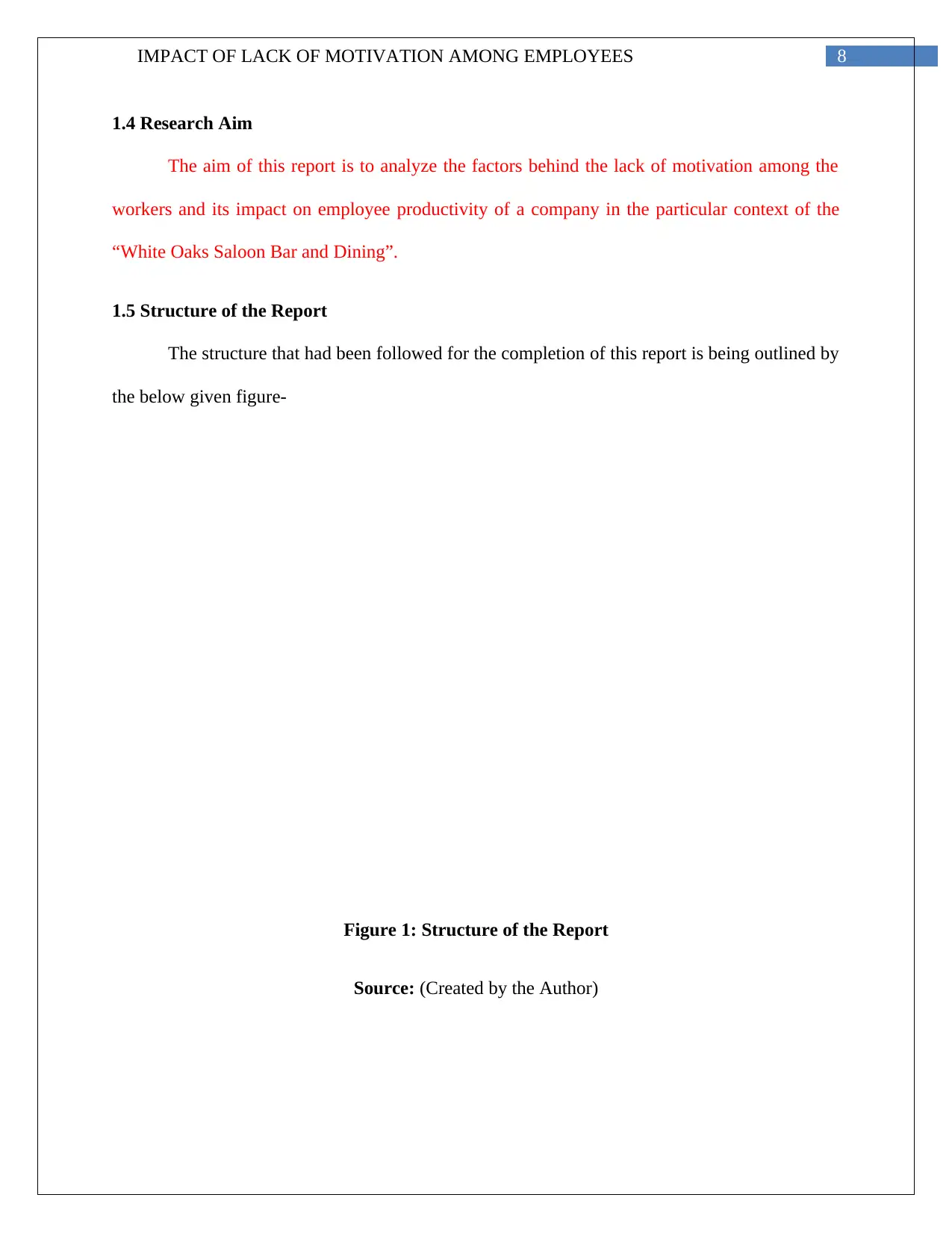
8IMPACT OF LACK OF MOTIVATION AMONG EMPLOYEES
1.4 Research Aim
The aim of this report is to analyze the factors behind the lack of motivation among the
workers and its impact on employee productivity of a company in the particular context of the
“White Oaks Saloon Bar and Dining”.
1.5 Structure of the Report
The structure that had been followed for the completion of this report is being outlined by
the below given figure-
Figure 1: Structure of the Report
Source: (Created by the Author)
Chapter5:Discussion
1.4 Research Aim
The aim of this report is to analyze the factors behind the lack of motivation among the
workers and its impact on employee productivity of a company in the particular context of the
“White Oaks Saloon Bar and Dining”.
1.5 Structure of the Report
The structure that had been followed for the completion of this report is being outlined by
the below given figure-
Figure 1: Structure of the Report
Source: (Created by the Author)
Chapter5:Discussion
⊘ This is a preview!⊘
Do you want full access?
Subscribe today to unlock all pages.

Trusted by 1+ million students worldwide
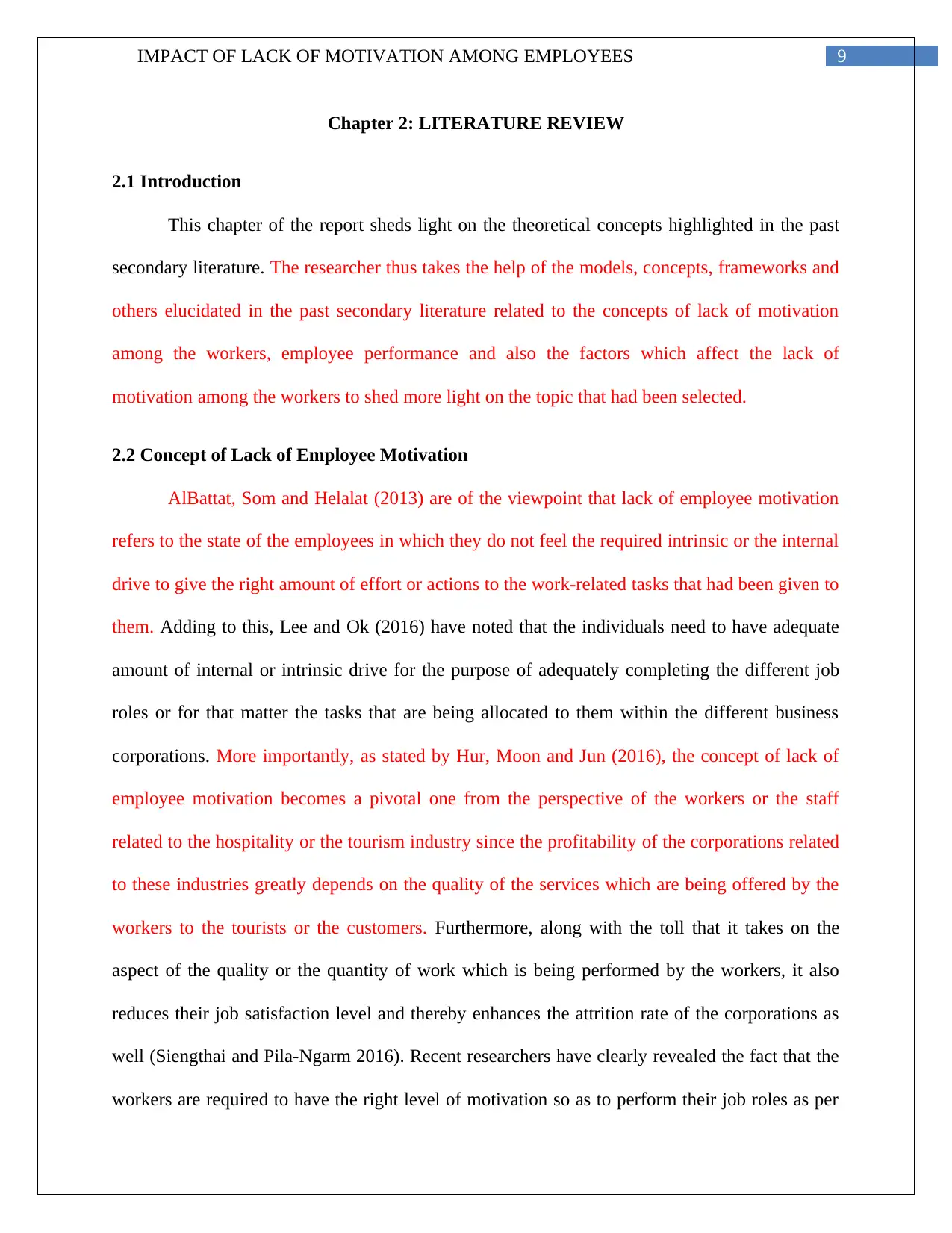
9IMPACT OF LACK OF MOTIVATION AMONG EMPLOYEES
Chapter 2: LITERATURE REVIEW
2.1 Introduction
This chapter of the report sheds light on the theoretical concepts highlighted in the past
secondary literature. The researcher thus takes the help of the models, concepts, frameworks and
others elucidated in the past secondary literature related to the concepts of lack of motivation
among the workers, employee performance and also the factors which affect the lack of
motivation among the workers to shed more light on the topic that had been selected.
2.2 Concept of Lack of Employee Motivation
AlBattat, Som and Helalat (2013) are of the viewpoint that lack of employee motivation
refers to the state of the employees in which they do not feel the required intrinsic or the internal
drive to give the right amount of effort or actions to the work-related tasks that had been given to
them. Adding to this, Lee and Ok (2016) have noted that the individuals need to have adequate
amount of internal or intrinsic drive for the purpose of adequately completing the different job
roles or for that matter the tasks that are being allocated to them within the different business
corporations. More importantly, as stated by Hur, Moon and Jun (2016), the concept of lack of
employee motivation becomes a pivotal one from the perspective of the workers or the staff
related to the hospitality or the tourism industry since the profitability of the corporations related
to these industries greatly depends on the quality of the services which are being offered by the
workers to the tourists or the customers. Furthermore, along with the toll that it takes on the
aspect of the quality or the quantity of work which is being performed by the workers, it also
reduces their job satisfaction level and thereby enhances the attrition rate of the corporations as
well (Siengthai and Pila-Ngarm 2016). Recent researchers have clearly revealed the fact that the
workers are required to have the right level of motivation so as to perform their job roles as per
Chapter 2: LITERATURE REVIEW
2.1 Introduction
This chapter of the report sheds light on the theoretical concepts highlighted in the past
secondary literature. The researcher thus takes the help of the models, concepts, frameworks and
others elucidated in the past secondary literature related to the concepts of lack of motivation
among the workers, employee performance and also the factors which affect the lack of
motivation among the workers to shed more light on the topic that had been selected.
2.2 Concept of Lack of Employee Motivation
AlBattat, Som and Helalat (2013) are of the viewpoint that lack of employee motivation
refers to the state of the employees in which they do not feel the required intrinsic or the internal
drive to give the right amount of effort or actions to the work-related tasks that had been given to
them. Adding to this, Lee and Ok (2016) have noted that the individuals need to have adequate
amount of internal or intrinsic drive for the purpose of adequately completing the different job
roles or for that matter the tasks that are being allocated to them within the different business
corporations. More importantly, as stated by Hur, Moon and Jun (2016), the concept of lack of
employee motivation becomes a pivotal one from the perspective of the workers or the staff
related to the hospitality or the tourism industry since the profitability of the corporations related
to these industries greatly depends on the quality of the services which are being offered by the
workers to the tourists or the customers. Furthermore, along with the toll that it takes on the
aspect of the quality or the quantity of work which is being performed by the workers, it also
reduces their job satisfaction level and thereby enhances the attrition rate of the corporations as
well (Siengthai and Pila-Ngarm 2016). Recent researchers have clearly revealed the fact that the
workers are required to have the right level of motivation so as to perform their job roles as per
Paraphrase This Document
Need a fresh take? Get an instant paraphrase of this document with our AI Paraphraser

10IMPACT OF LACK OF MOTIVATION AMONG EMPLOYEES
the expectations of the target market that they serve or for that matter as per the expectations of
the corporations that they work for (Chand and Ranga 2018). Thus, it becomes important for the
business corporations to take the help of adequate measures so as to enhance the employee
motivation and thereby overcome the issues or the challenges posed by lack of employee
motivation.
2.3 Factors affecting Lack of Employee motivation
2.3.1 Salary and Remuneration
As per Adam’s Equity theory of motivation, offering equal amount of wages of
remuneration to the workers performing the same kind of tasks or for that matter the job roles
substantially motivates the workers and thereby greatly improves both the quantity and the
quality of the work which is being performed by them (Hanaysha and Tahir 2016). However, as
discussed by Lu and Gursoy (2016), the problem arises since within the different business
corporations it had been seen that the workers are being offered remuneration on the basis of the
nature of the work roles that they perform, their qualifications, prior job experience and other
aspects. More importantly, often it is seen that the workers who perform more laborious or
important jobs are being offered below-par remuneration in comparison to others and this in turn
causes a substantial amount of de-motivation among them (Lee, Back and Chan 2015). Thus, it
becomes important for the business corporations to follow the system of “Equal Work Equal
Pay” for the remuneration that they offer to their workers. This in turn will help the business
corporations to adequately motivate their workers and thereby overcome the issue of lack of
employee motivation.
the expectations of the target market that they serve or for that matter as per the expectations of
the corporations that they work for (Chand and Ranga 2018). Thus, it becomes important for the
business corporations to take the help of adequate measures so as to enhance the employee
motivation and thereby overcome the issues or the challenges posed by lack of employee
motivation.
2.3 Factors affecting Lack of Employee motivation
2.3.1 Salary and Remuneration
As per Adam’s Equity theory of motivation, offering equal amount of wages of
remuneration to the workers performing the same kind of tasks or for that matter the job roles
substantially motivates the workers and thereby greatly improves both the quantity and the
quality of the work which is being performed by them (Hanaysha and Tahir 2016). However, as
discussed by Lu and Gursoy (2016), the problem arises since within the different business
corporations it had been seen that the workers are being offered remuneration on the basis of the
nature of the work roles that they perform, their qualifications, prior job experience and other
aspects. More importantly, often it is seen that the workers who perform more laborious or
important jobs are being offered below-par remuneration in comparison to others and this in turn
causes a substantial amount of de-motivation among them (Lee, Back and Chan 2015). Thus, it
becomes important for the business corporations to follow the system of “Equal Work Equal
Pay” for the remuneration that they offer to their workers. This in turn will help the business
corporations to adequately motivate their workers and thereby overcome the issue of lack of
employee motivation.

11IMPACT OF LACK OF MOTIVATION AMONG EMPLOYEES
2.3.2 Work Stress and Pressure
Horng et al. (2016) are of the viewpoint that the work stress or for that matter the work
pressure that the workers are required to handle within the cauldron of a particular business
corporation greatly influences their motivation level. As discussed by Punjaisri and Wilson
(2017), if the work stress or the work pressure faced by the workers is too high then this not only
adversely affects their wellbeing but at the same time starts to make them feel less motivated as
well. More importantly, a high level of work stress faced by the workers adversely affects the
effective fulfillment of their basic needs within the workplaces of the different business
corporations which are important from the perspective of productivity and wellbeing
(Darvishmotevali, Arasli and Kilic 2017). Furthermore, the entity of work stress also adversely
affects the work-life balance of the workers as well which in turn substantially contributes
towards the lack of motivation faced by the workers. In addition to these, Vroom’s Expectancy
theory states that the behavior displayed by the workers is the end result of the conscious choices
made by them which are intended to maximize their pleasure within the business corporations
(Tsai et al. 2015). However, the high work stress faced by the workers adversely affects the work
pleasure of the workers and thereby contributes towards the lack of employee motivation (Guest
2017). Thus, it can be said that the high work stress or work pressure faced by the workers within
a particular business corporation is an important factors which affects the entity of employee
motivation.
2.3.3 Awards and Recognition
According to Putra, Cho and Liu (2017), rewards and recognition is an important
measure which is being used by the contemporary business corporations for the purpose of
motivating their workers. Lundberg, Gudmundson and Andersson (2009) have noted that the
2.3.2 Work Stress and Pressure
Horng et al. (2016) are of the viewpoint that the work stress or for that matter the work
pressure that the workers are required to handle within the cauldron of a particular business
corporation greatly influences their motivation level. As discussed by Punjaisri and Wilson
(2017), if the work stress or the work pressure faced by the workers is too high then this not only
adversely affects their wellbeing but at the same time starts to make them feel less motivated as
well. More importantly, a high level of work stress faced by the workers adversely affects the
effective fulfillment of their basic needs within the workplaces of the different business
corporations which are important from the perspective of productivity and wellbeing
(Darvishmotevali, Arasli and Kilic 2017). Furthermore, the entity of work stress also adversely
affects the work-life balance of the workers as well which in turn substantially contributes
towards the lack of motivation faced by the workers. In addition to these, Vroom’s Expectancy
theory states that the behavior displayed by the workers is the end result of the conscious choices
made by them which are intended to maximize their pleasure within the business corporations
(Tsai et al. 2015). However, the high work stress faced by the workers adversely affects the work
pleasure of the workers and thereby contributes towards the lack of employee motivation (Guest
2017). Thus, it can be said that the high work stress or work pressure faced by the workers within
a particular business corporation is an important factors which affects the entity of employee
motivation.
2.3.3 Awards and Recognition
According to Putra, Cho and Liu (2017), rewards and recognition is an important
measure which is being used by the contemporary business corporations for the purpose of
motivating their workers. Lundberg, Gudmundson and Andersson (2009) have noted that the
⊘ This is a preview!⊘
Do you want full access?
Subscribe today to unlock all pages.

Trusted by 1+ million students worldwide
1 out of 40
Related Documents
Your All-in-One AI-Powered Toolkit for Academic Success.
+13062052269
info@desklib.com
Available 24*7 on WhatsApp / Email
![[object Object]](/_next/static/media/star-bottom.7253800d.svg)
Unlock your academic potential
Copyright © 2020–2025 A2Z Services. All Rights Reserved. Developed and managed by ZUCOL.





